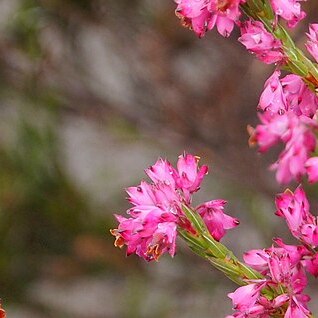Erect shrub up to about 45 cm (1 1/2 ft), glabrous except where otherwise stated. Branches erect or spreading, glabrous, rarely puberulous. Leaves usually 3-nate, occasionally opposite, 3-9 mm long, more or less adpressed to the branches, imbricate at first, later about equal to the internodes, narrow-elliptical, acute, keeled and sulcate, concave, scarious-edged, the floral sometimes large and sepaloid. Flowers terminal in clusters, calycine; peduncles 3-4 mm long; bracts 3-8 mm long, two median, one basal or wanting and, like the sepals, very variable in shape from lanceolate to very broad obovate, scarious, coloured and tipped with a darker keel. Sepals 3-8 mm long, a little shorter or a little longer than the corolla, imbricate below, wide-spreading, smooth, sometimes.shining, bright rosy to white. Corolla 3-10 mm long, tubular-urceolate to ovoid-urceolate, dry, bright rosy-red to white, usually paler below; lobes 1/4-1/3 the length of the tube, ovate, acute or acuminate, wide-spreading at first, later connivent and turning brown. Anthers included, 0.8 mm long, lateral, cuneate to oblong, appendiculate; pore about 1/2 the length of the cell; crests about 1/2 the length of the cell, lanceolate to ovate, incised or minutely serrate. Ovary oblong; style included; stigma capitate.
Erect shrublet to 1 m. Flowers small to medium, calycine, urn-shaped, pink soon turning brown at tips.

